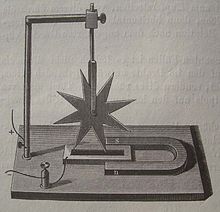Barlow wheel
The Barlow's wheel , also written as Barlow's wheel or Barlow wheel , is a homopolar motor , i.e. a device (without a commutator) set in rotation with direct current. It was realized by Peter Barlow in 1822.
construction
A horizontally mounted, massive disk made of highly conductive non-ferrous metal (e.g. copper or aluminum ) is axially flooded by a magnetic field. The edge of the disc is immersed in a conductive liquid at the lower end. In the original Barlow uses mercury , but sodium chloride solution can also be used for demonstration purposes. Galinstan is also suitablewhich, as a mercury substitute, comes closest to mercury with its physical properties. However, aluminum and Galinstan react exothermically when water is added, which is why in this case the replica should take place with copper. If the bike is operated for a longer period of time, the Galinstans may "silt up" due to oxidation.
In a letter to Alexander Tilloch , editor of Philosophical Magazine , Barlow writes that his wheel had 16 points and was made of thin copper sheet. He chose copper wire for the suspension and somewhat thicker copper or brass wire for the gallows. He gave no information about the exact dimensions.
functionality
For the experiment to work, charge carriers must flow through the disk in a radial direction. The mercury bath connects the edge of the disk with one pole of a DC voltage source. The other pole is placed on the axis on which the disc is mounted.
The charge carriers are deflected by the magnetic field due to the Lorentz force . A simple model of the movement of the charge carriers in metals ( electrons ) says that the movement of the electrons counteracts a kind of “friction” (caused by collisions with the atoms of the lattice) and the charge carriers reach a defined speed, the drift speed . The Barlow's wheel confirms this model concept in that the disk begins to turn. If there were no friction (or some related force), the disc would not be able to turn. Due to the orthogonality of the magnetic field and the direction of the electric current, the Lorentz force always acts tangentially to the wheel.
A similar attempt is the Lorentz carousel . The reverse of the phenomenon, the generation of a voltage by rotating a conductive disk in an axial magnetic field, is called unipolar induction , the corresponding generator is called a unipolar machine .
literature
- Wolfgang Demtröder : Experimentalphysik 2 ISBN 3-540-20210-2 .
- Helmut Vogel: Gerthsen Physik ISBN 3-540-62988-2 .
Individual evidence
- ↑ Das Barlowsche Rad. (No longer available online.) Europa-Universität Flensburg, Department of Physics and its Didactics and History, July 9, 2015, archived from the original on August 13, 2017 ; accessed on June 18, 2016 (description of an exhibit in the HistoLab). Info: The archive link was inserted automatically and has not yet been checked. Please check the original and archive link according to the instructions and then remove this notice.
- ^ Peter Barlow: A curious electro-magnetic experiment. The Philosophical Magazine and Journal, Issue 59, 1822.
Web links
- Barlow wheel by Ekling (1840)
